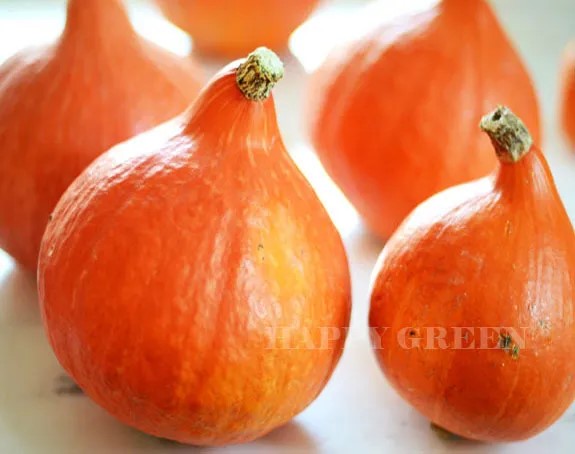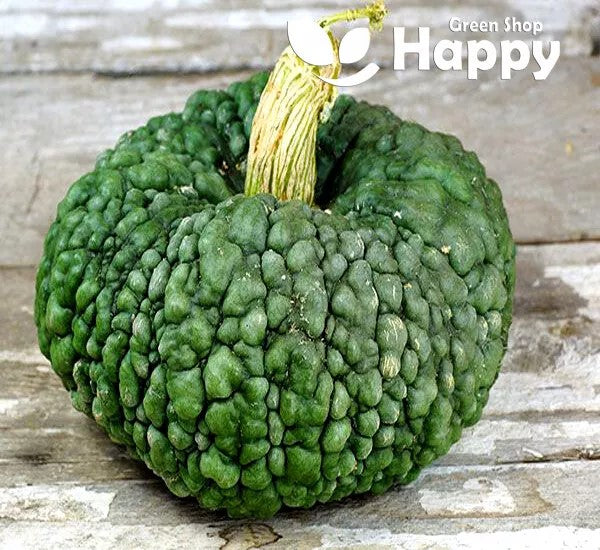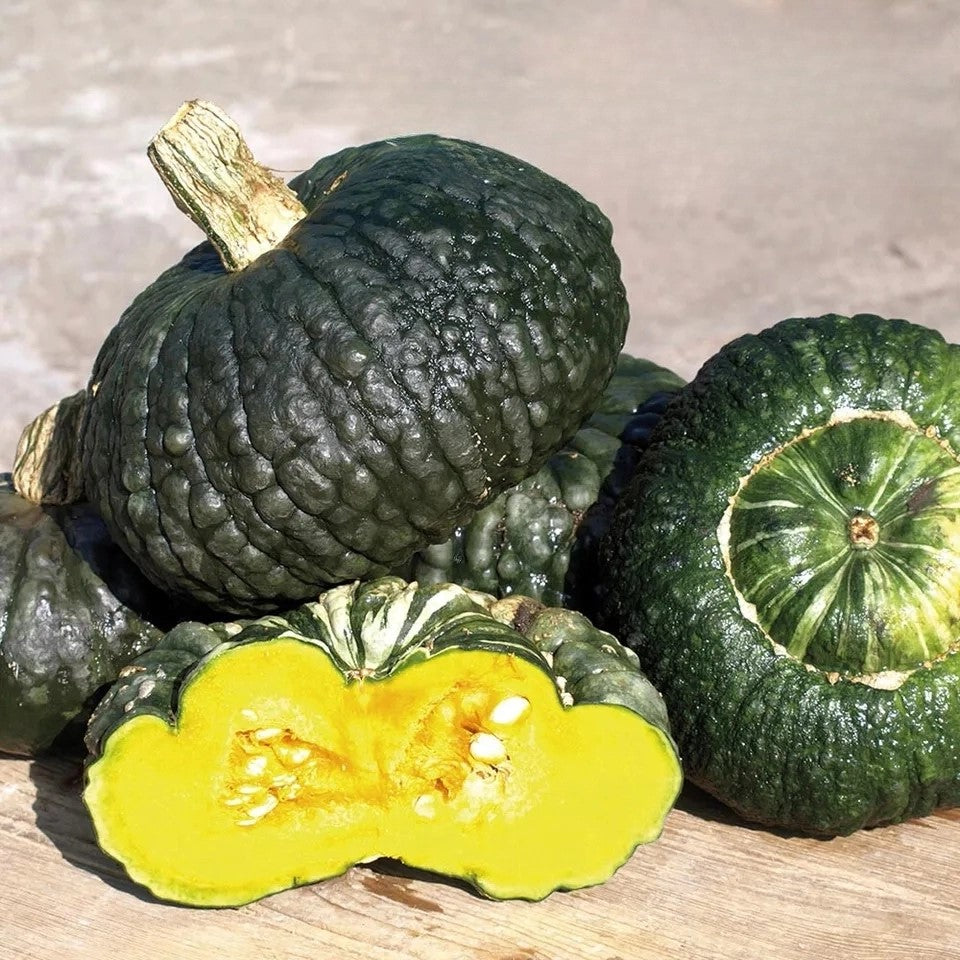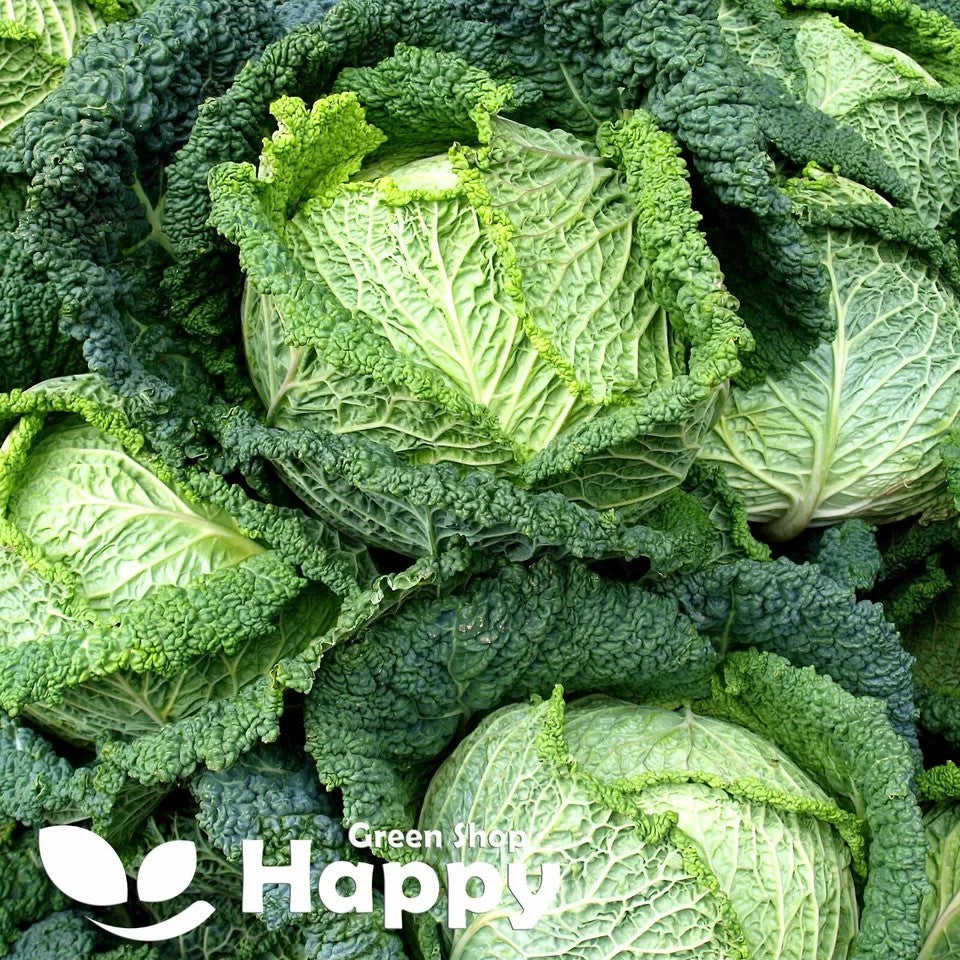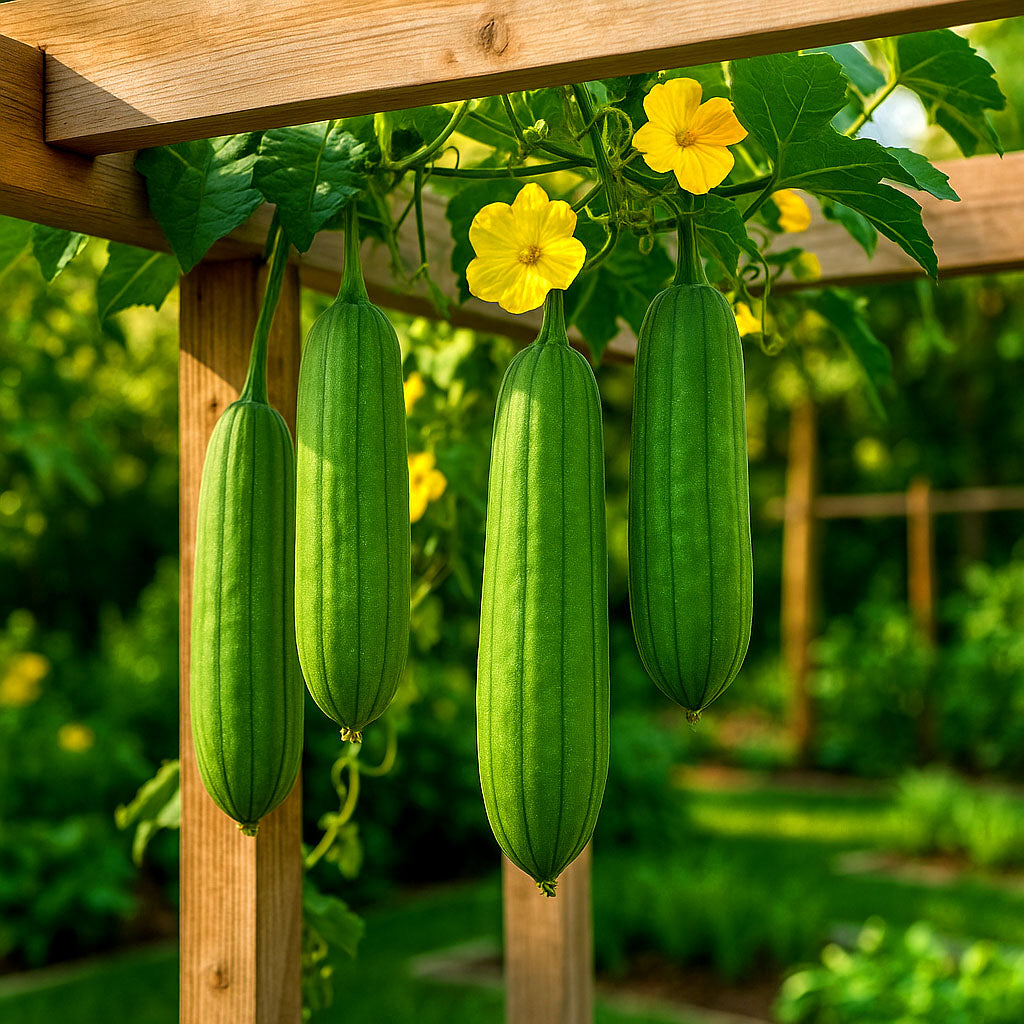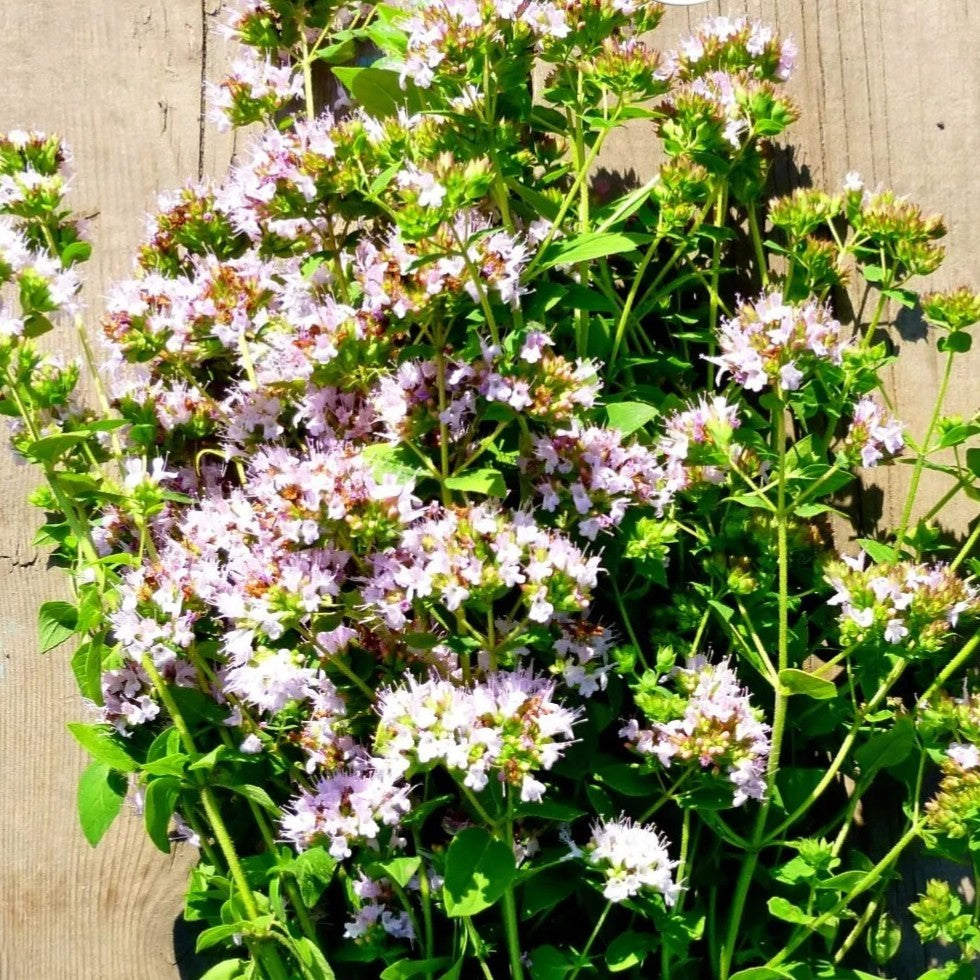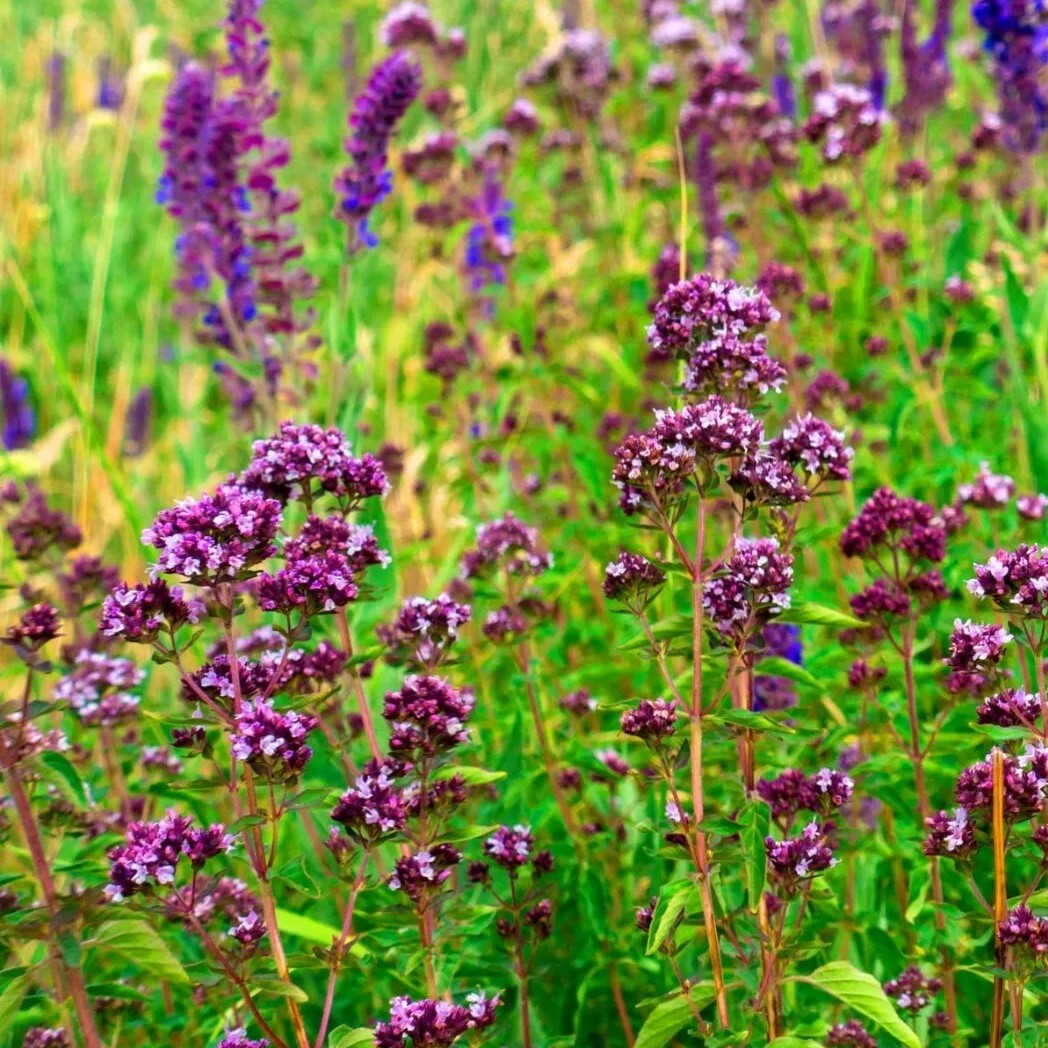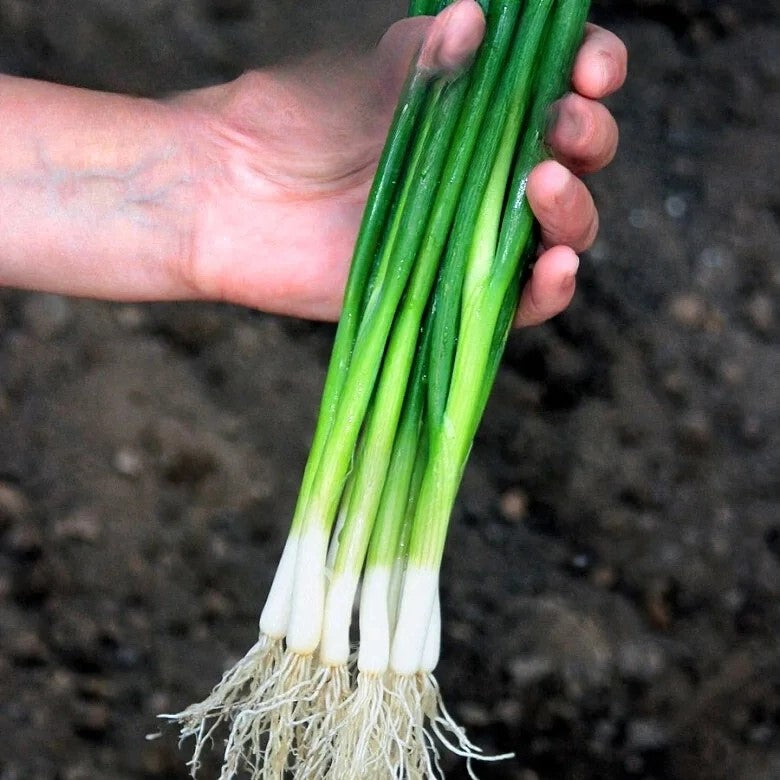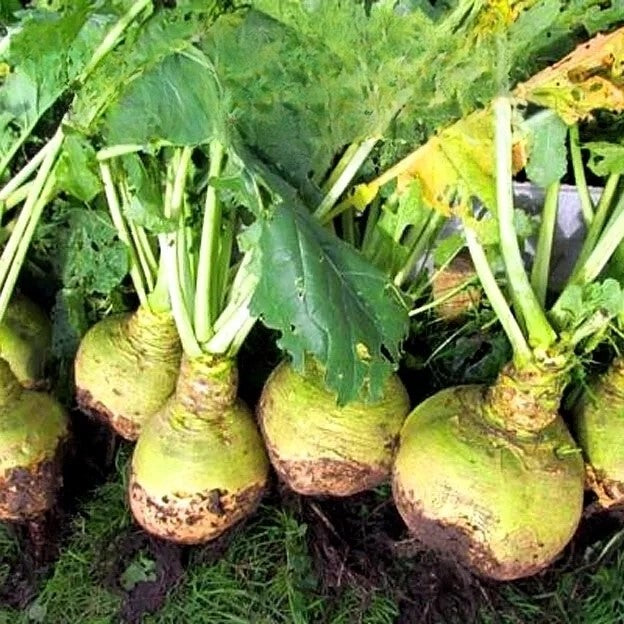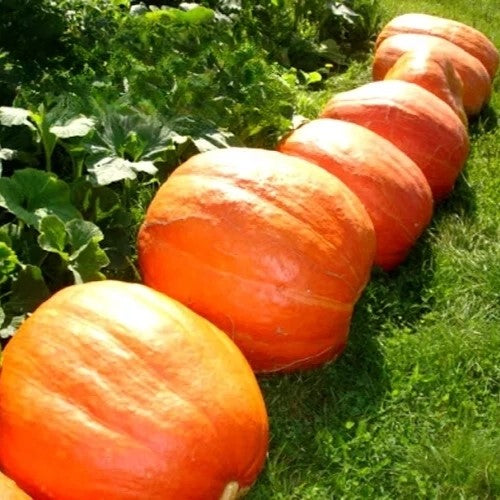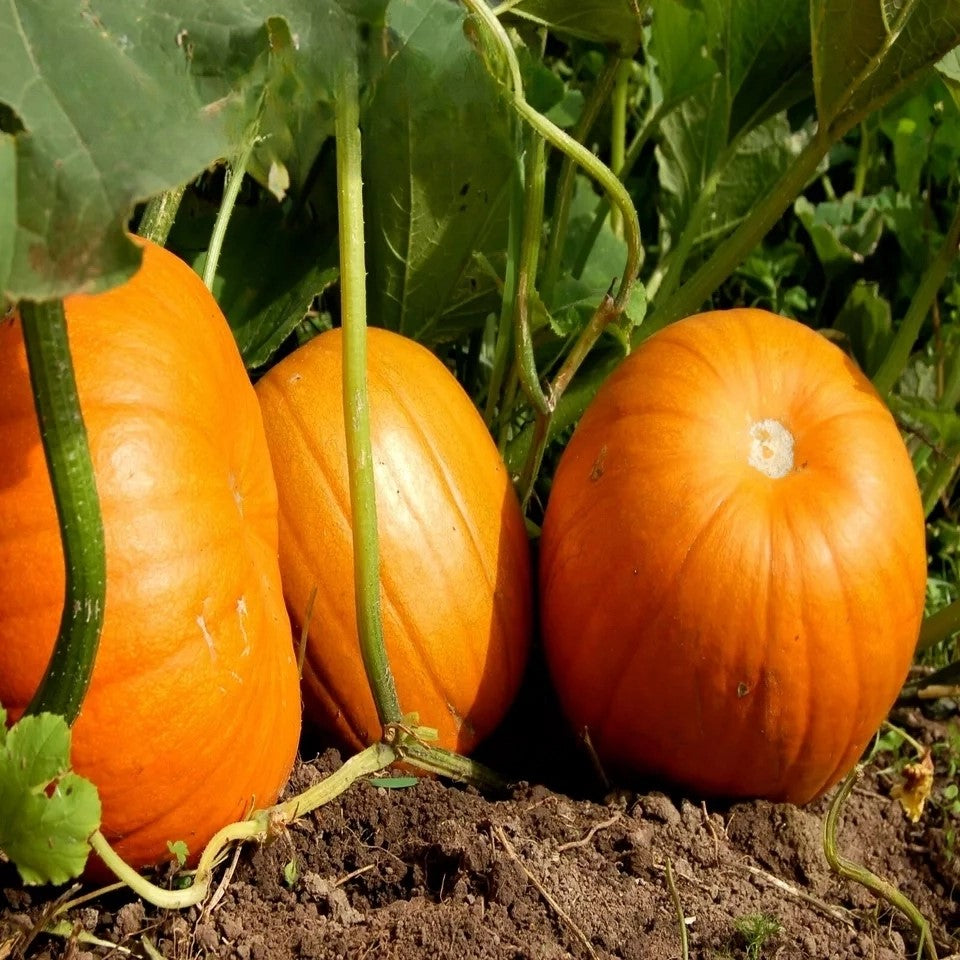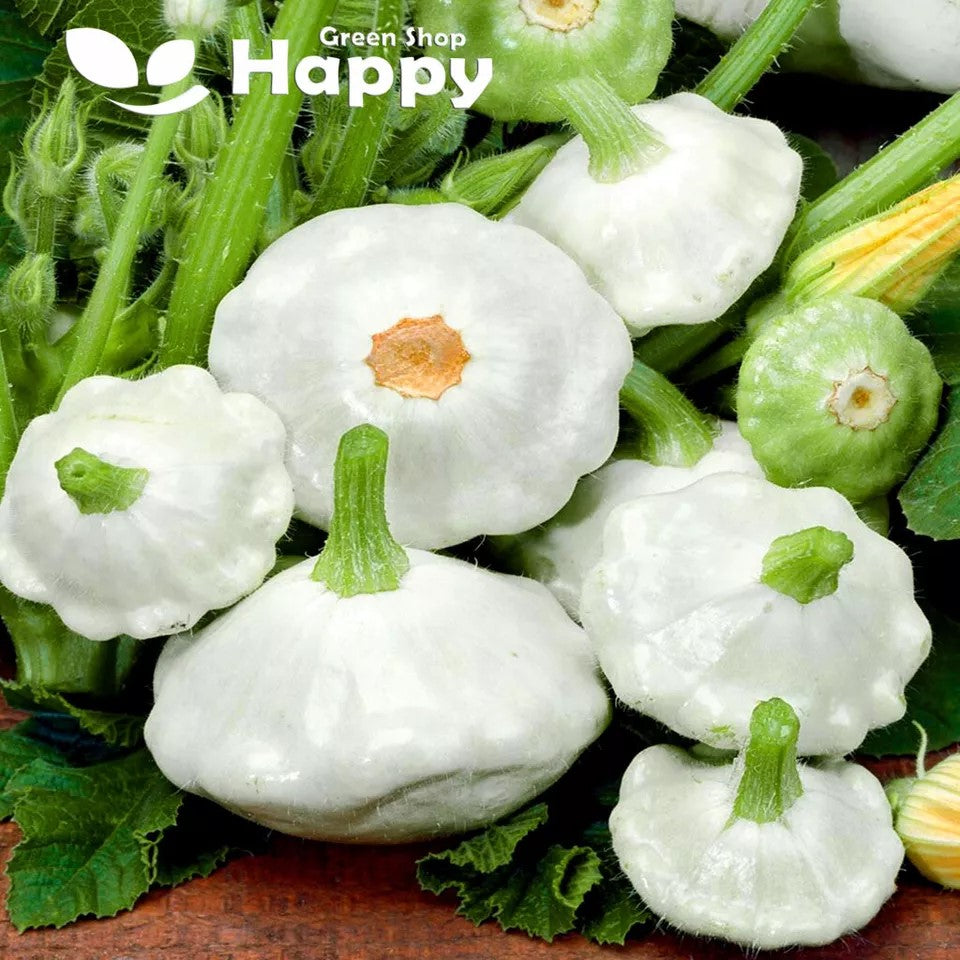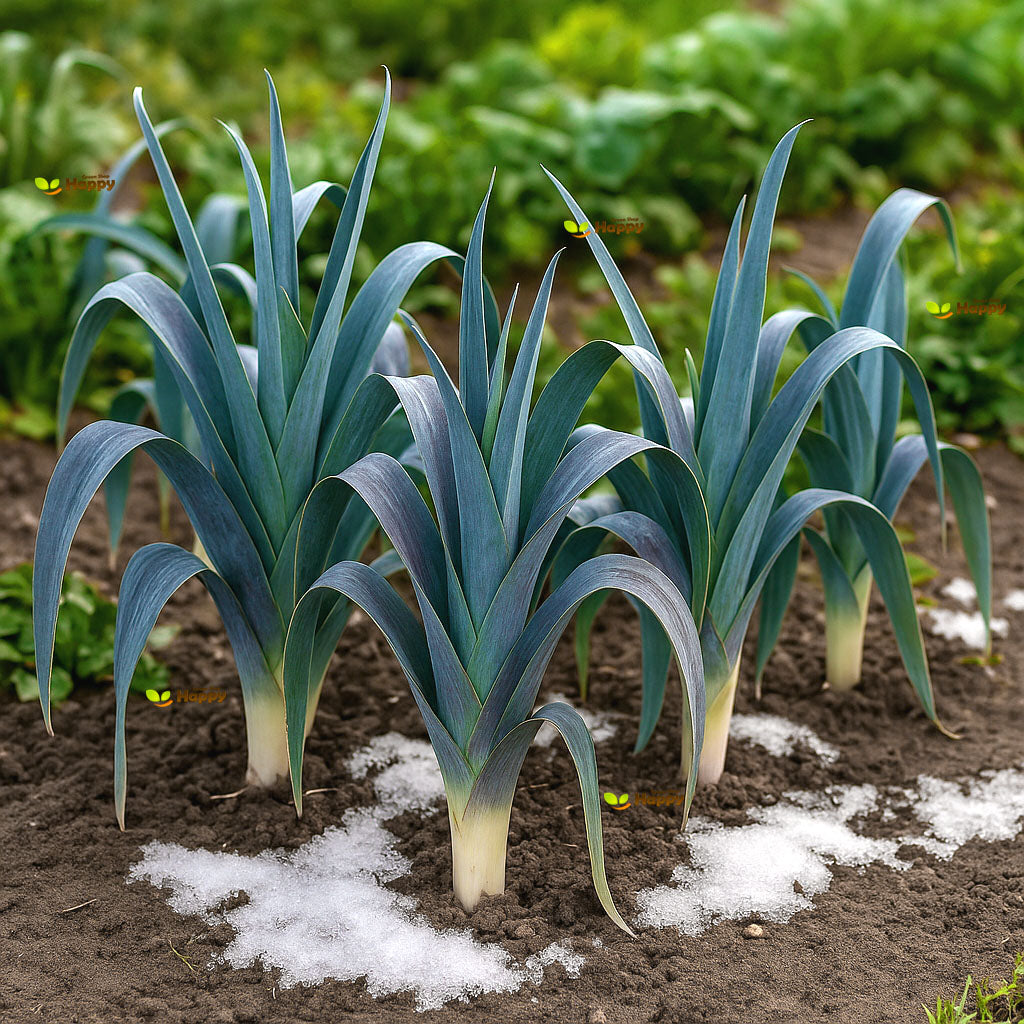Sort by:
16 products
16 products
Squash 'Uchiki Kuri' Seeds (Cucurbita maxima)
Discover the gourmet favorite Squash 'Uchiki Kuri', also known as the Red Kuri or Onion Squash. This reliable Japanese variety produces small, tear-drop shaped fruits with vibrant orange skin and rich, nutty-sweet golden flesh. Perfect for roasting, soups, curries, and baking, it’s a versatile squash that stores well for winter use.
How to Grow
-
Sow indoors in late spring or directly outdoors after frost.
-
Prefers fertile, well-drained soil in full sun.
-
Sow 2–3 seeds 2 cm deep in small pots or stations.
-
Transplant or thin to one strong plant per station, 90–120 cm apart.
-
Water regularly and feed for strong growth.
Key Features
-
Traditional Japanese squash with bright orange fruits
-
Nutty, sweet flavor with smooth golden flesh
-
Compact, manageable fruits (1–2 kg each)
-
Stores well for winter use
-
High-yielding and easy to grow
Ideal For
-
Roasting, soups, curries, and baking
-
Winter storage and long-lasting kitchen use
-
Home gardeners seeking gourmet squash varieties
-
Allotments, vegetable beds, or spacious gardens
Sowing
-
Best time: April to June
-
Depth: 2 cm
-
Spacing: 90–120 cm between plants
-
Position: Full sun, fertile soil
-
Harvest: September to October
Quick Tip
-
Cure fruits in the sun after harvest for longer storage life and enhanced sweetness.
Squash 'Marina di Chioggia' – Seeds (Cucurbita maxima)
The 'Marina di Chioggia' squash is a traditional Italian heirloom variety, prized for its rugged, dark green, warty skin and rich, sweet orange flesh. Originating from the coastal town of Chioggia near Venice, this unique pumpkin has been a staple in Italian markets for centuries and is still beloved today for its superb flavor in soups, gnocchi, risottos, and baking.
Its fruits are typically 3–5 kg, round, and deeply ribbed, with a long storage life that makes them excellent for use throughout the winter months. A true standout in the garden and kitchen alike!
How to Grow
. Sow indoors: April – May in pots, 2–3 cm deep
. Transplant outdoors: Late May – June, after frost risk has passed
. Sow outdoors: May – June, directly in the ground
. Spacing: 1 m apart in rich, well-drained soil
. Harvest: September – October, when fruits are fully ripened
Key Features
. Italian heirloom pumpkin with striking warty skin
. Fruits weigh 3–5 kg, perfect for storage
. Sweet, dense, orange flesh – ideal for roasting, soups & baking
. Long-keeping winter squash
. Traditional variety still popular in Venice markets
Ideal For
. Traditional and heritage vegetable gardens
. Chefs and home cooks seeking authentic Italian flavors
. Long-term winter storage
. Eye-catching display in kitchen gardens and autumn harvests
Sowing & Harvesting
. Sow: April – June
. Harvest: September – October
Quick Tip
For best results, feed regularly with compost or organic fertilizer and allow fruits to ripen fully on the vine for maximum sweetness.
Winter Savoy Cabbage 'Vertus 2' – Seeds (Brassica oleracea)
The Winter Savoy Cabbage 'Vertus 2' is a traditional, hardy variety producing large, dense, medium-green heads with attractive crinkled leaves. It is highly reliable for late autumn and winter harvests, offering sweet, tender leaves perfect for both cooking and fresh use.
This variety thrives in colder climates, with excellent frost resistance that enhances its flavor and texture. A top choice for gardeners seeking a dependable winter vegetable.
How to Grow
-
Sow indoors: March – May
-
Sow outdoors: April – June
-
Transplant/Thin: 40–50 cm apart
-
Soil: Fertile, firm, moisture-retentive
-
Position: Full sun
-
Care: Keep soil consistently moist and protect young plants from cabbage pests
Key Features
-
Traditional winter savoy cabbage variety
-
Large, dense heads with crinkled leaves
-
Excellent frost resistance and winter hardiness
-
Sweet, tender flavor ideal for cooking
-
Reliable and productive for cold seasons
Sowing & Harvest
-
Sow: March – June
-
Harvest: October – February
Vegetable Sponge – Seeds (Luffa cylindrica)
Grow your own natural sponges with Luffa cylindrica, also known as the vegetable sponge or loofah. This fascinating gourd plant produces long green fruits that, when matured and dried, reveal a fibrous interior perfect for eco-friendly sponges, bath accessories, and natural scrubbers. Young fruits can also be cooked and eaten like courgettes. A rewarding and unique plant for gardeners who love trying something different.
How to Grow
. Sow indoors in April, 1–2 cm deep in pots of moist compost, keeping them warm (20–25°C)
. Transplant outdoors or into a greenhouse after the last frost, spacing 60–90 cm apart
. Requires full sun, warmth, and rich, well-drained soil
. Support with trellis or canes for climbing vines
. Harvest young fruits for eating, or allow to mature fully for sponges
Key Features
. Produces natural loofah sponges when dried
. Young fruits edible, similar to courgettes
. Vigorous climbing plant with long vines
. Thrives in warm, sunny conditions
. Unique and sustainable garden crop
Ideal For
. Eco-friendly bath and kitchen sponges
. Gardeners who enjoy unusual crops
. Warm gardens, greenhouses, or polytunnels
. DIY natural skincare and household uses
Sowing & Harvest
. Sow: April – May
. Harvest: August – October (young fruits) or later for mature loofahs
Quick Tip
For sponges, leave fruits on the plant until skins turn yellow and dry, then peel to reveal the fibrous loofah inside.
Wild Marjoram – Oregano – Seeds (Origanum vulgare)
Wild Marjoram (Oregano) is a hardy perennial herb cherished for its fragrant leaves and delicate pink-purple flowers. A staple of Mediterranean cooking, oregano adds a rich, earthy flavor to pizzas, pasta, sauces, and roasted vegetables. Beyond the kitchen, its nectar-rich flowers are a magnet for bees and butterflies, making it a wonderful addition to herb gardens, borders, and pollinator-friendly spaces.
How to Grow
-
Sow indoors: March – May in seed trays or pots.
-
Transplant outdoors: After the last frost in a sunny, well-drained spot.
-
Spacing: 25–30 cm apart.
-
Oregano prefers light, well-drained soil and thrives in warm, sunny conditions.
Key Features
-
Aromatic herb essential for Mediterranean cuisine
-
Hardy perennial, easy to grow
-
Attracts bees and butterflies with summer blooms
-
Suitable for pots, containers, or borders
-
Drought-tolerant once established
Ideal For
-
Culinary herb gardens
-
Fresh or dried use in cooking
-
Pollinator-friendly borders
-
Container growing on patios or balconies
Sowing & Harvest
-
Sow: March – May
-
Harvest: June – October (leaves can be harvested fresh or dried)
Quick Tip
For the most intense flavor, harvest oregano leaves just before flowering, and dry them in a cool, airy place.
Curly Kale 'Sympatic' – Seeds (Brassica oleracea var. sabellica)
The Curly Kale 'Sympatic' is a vigorous and reliable kale variety, known for its decorative, tightly curled green leaves and excellent winter hardiness. This hardy leafy green thrives in cooler weather and can be harvested for many months, making it a staple crop for any kitchen garden.
Kale 'Sympatic' has a sweet, mild flavor that improves after the first frosts, when the leaves become more tender and less bitter. Perfect for soups, stews, stir-fries, smoothies, or simply steamed as a healthy side. The upright plants are also highly ornamental, adding texture and vibrant color to vegetable beds and borders.
How to Grow
-
Sow indoors: March – May
-
Sow outdoors: April – June, thinly in rows 1 cm deep
-
Transplant/Thin: 45 cm apart when seedlings are large enough
-
Position: Full sun or partial shade
-
Soil: Moist, fertile, well-drained soil enriched with compost
-
Care: Water regularly and protect young plants from cabbage pests
Key Features
-
Hardy curly kale with decorative, ruffled leaves
-
Reliable growth and long cropping season
-
Flavour sweetens after frost
-
Nutrient-rich superfood, packed with vitamins A, C, and K
-
Great for winter harvests when little else grows
Harvest
-
Harvesting period: October – March
-
Pick outer leaves regularly, allowing the plant to continue producing throughout winter.
Short Tip
For the sweetest flavor, leave plants in the ground until after the first frosts – the cold enhances the natural sugars in the leaves.
Swede – Seeds (Brassica napus)
Swede (also known as rutabaga or Swedish turnip) is a hardy root vegetable that produces large, round roots with golden-yellow flesh and a sweet, earthy flavor. It is an excellent choice for winter storage and a versatile kitchen staple, ideal for roasting, mashing, stews, and soups.
This traditional cool-season crop is easy to grow, highly nutritious, and a reliable addition to any vegetable garden or allotment.
How to Grow
-
Sow outdoors: May – July
-
Depth: 1–2 cm
-
Spacing: 20 cm apart in rows 40 cm apart
-
Position: Full sun
-
Soil: Fertile, firm, well-drained soil enriched with compost
-
Watering: Keep soil moist during dry spells to avoid woody roots
Key Features
-
Traditional root crop with sweet, golden-yellow flesh
-
Excellent for roasting, mashing, soups, and stews
-
Stores well for use throughout winter
-
Hardy and reliable in cooler climates
-
Easy to grow with minimal care
Harvest
-
Harvesting period: October – February
-
Lift roots as needed for fresh use or store for winter months.
Short Tip
Thin seedlings early to give roots space to develop fully.
Pumpkin 'Golias' – Seeds
(Cucurbita pepo) – Giant, Decorative & Edible Pumpkin
Pumpkin 'Golias' is an impressive giant pumpkin variety, producing extra-large, round fruits with smooth orange skin. Known for its huge size and vigorous growth, it makes a real garden showpiece while also being delicious in soups, bakes, and pies. Perfect for competitions, carving, or autumn displays.
Key Features
-
Type: Annual fruiting vegetable
-
Fruit size: Extra-large, giant pumpkins
-
Skin: Smooth orange
-
Flavor: Mild, sweet flesh suitable for cooking
-
Harvest: Late summer to autumn
-
Use: Cooking, carving, decoration, competitions
Ideal For
-
Giant vegetable growing
-
Autumn harvest festivals & carving
-
Cooking soups, pies, and bakes
-
Impressive garden displays
Sowing & Growing
-
Sow indoors: April–May, 2–3 cm deep in pots.
-
Transplant outdoors: Late May–June, after last frost.
-
Direct sowing: From mid-May, 2–3 cm deep.
-
Spacing: 1–1.5 m between plants.
-
Soil: Rich, fertile, well-drained with compost/manure.
-
Harvest: September–October, when skins harden.
Care Tips
-
Requires full sun and plenty of water.
-
Feed regularly for maximum fruit size.
-
Protect from frost – harvest before first frost arrives.
Patty Pan 'Custard White' – Seeds (Cucurbita pepo)
The Patty Pan 'Custard White' is a striking summer squash variety producing creamy white, scalloped fruits with a tender texture and mild, nutty flavor. These unique squashes can be harvested young for grilling, steaming, and stir-fries or left to mature for stuffing and baking. Both ornamental and delicious, they add variety to your kitchen garden and your plate.
How to Grow
-
Sow seeds indoors from April or directly outdoors from May once the soil has warmed.
-
Plant 2–3 seeds per hole, 2 cm deep, thinning to the strongest seedling.
-
Space plants 60–90 cm apart in sunny, fertile soil.
-
Water regularly and feed for a steady crop.
Key Features
-
Distinctive white, scalloped fruits
-
Tender flesh with mild, nutty flavor
-
Harvest young or mature depending on use
-
Highly productive and ornamental
-
Versatile for grilling, baking, or stuffing
Ideal For
-
Summer vegetable gardens
-
Home cooks seeking versatile squash
-
Decorative harvest baskets and kitchen displays
Sowing & Harvest
-
Sow: April to June
-
Harvest: July to October
Quick Tip
-
Harvest fruits when small and tender for the best flavor and a continuous crop.
Showing 9/16

